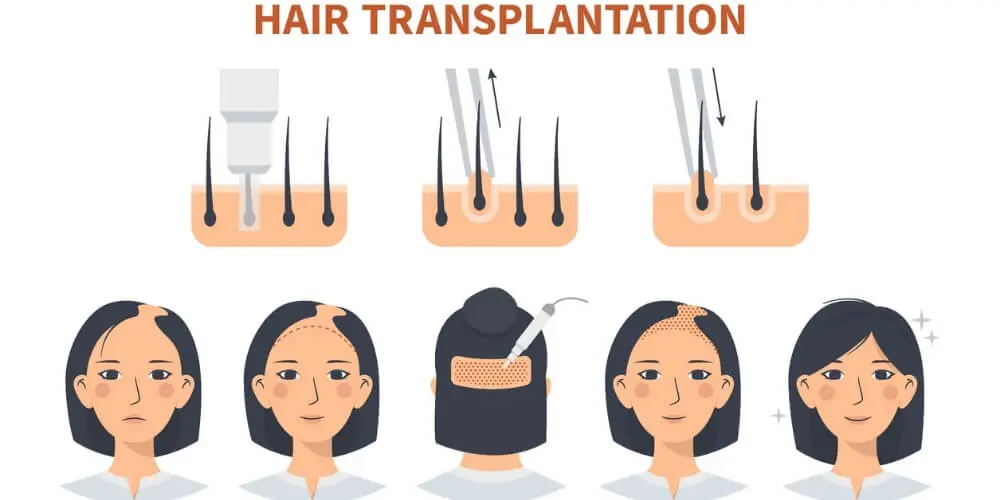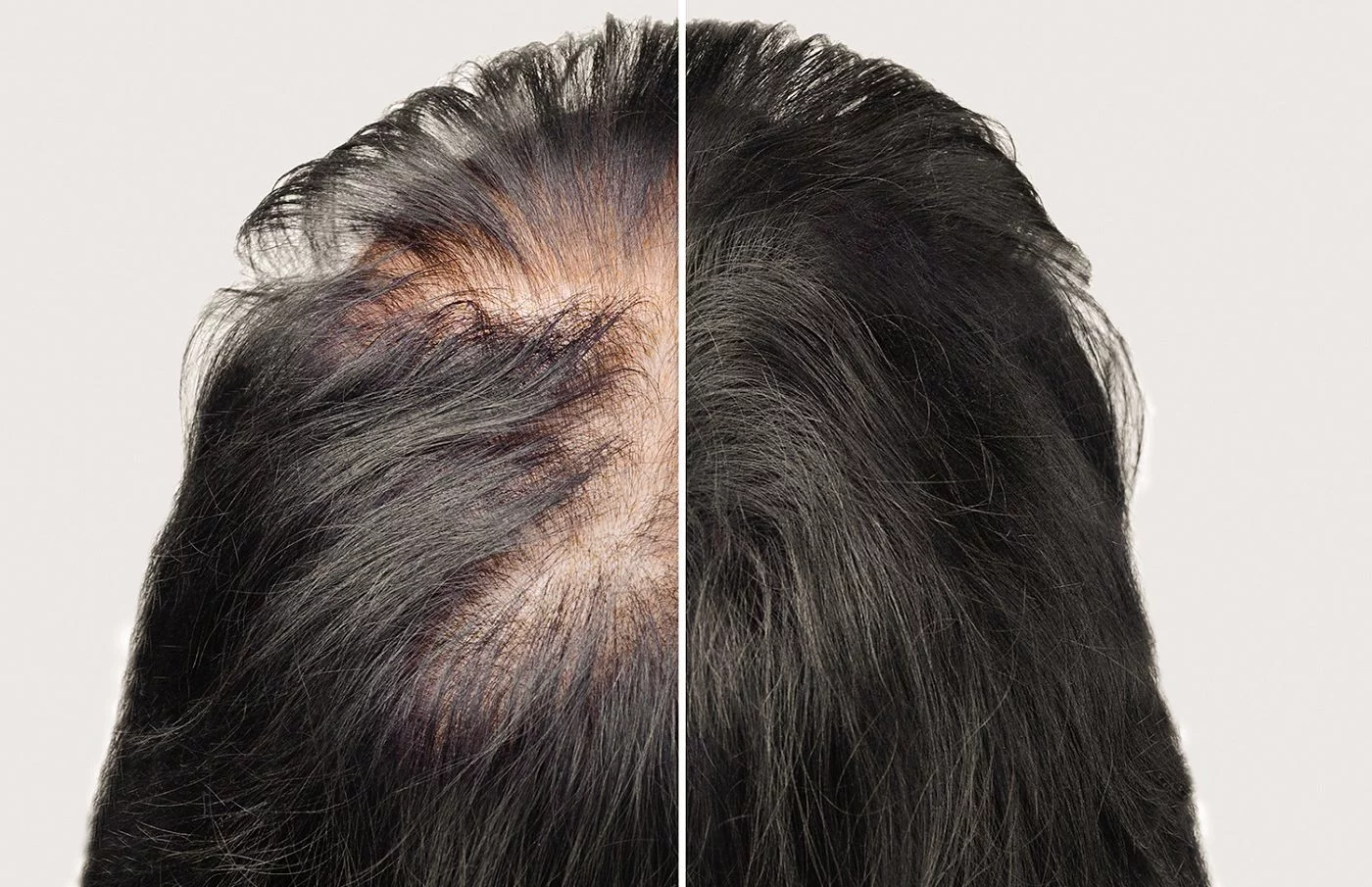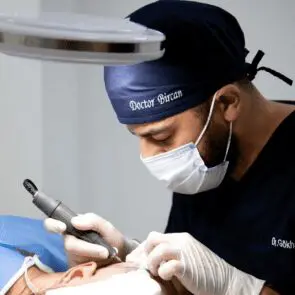Female Hair Transplant. How to Save Hair?
Women often come to us with the question: “Can you transplant my hair?” To which we send them to the doctor, because before transplanting hair we must clearly understand the cause of baldness.
Causes of baldness in women

In our experience, the main cause of baldness in about 90% of cases is diffuse alopecia. There may be different reasons: various infections, iron deficiency, hormonal changes, consequences after childbirth, consequences after taking various drugs, medications, chemotherapy. And in this case, before a consultation on hair transplantation, we give women a large list of tests and ask them to undergo all examinations and contact an endocrinologist so that he can accurately help determine the cause of alopecia. Because if you have diffuse alopecia, then after treatment, your hair will grow again and you do not need us, so we send 90% of women for treatment. But in 10% of cases, this is androgenic male pattern baldness, then you should come to us, then we can really do a hair transplant for you.
Types of Hair Transplants for Women
So, what types of hair transplants and what hair transplant zones are there for women? Most often, we perform transplants on the front line, when women have sort of lost their front growth line and it is necessary to thicken it there. We also perform transplants in the temporal zone, very often this is associated with the front line. And this is all within the framework of one operation. Sometimes we thicken along the parting line. If the patient wants to thicken the hair all over the head evenly, unfortunately, we will not help, because this is not entirely effective and is quite difficult to implement, so if you need to thicken the hair on the front line, temporal zones, along the parting line – contact us.
FUE and DHI transplant methods

What transplantation methods are used? There are two methods of hair transplantation: FUE and DHI. Each of these methods is used in each specific case depending on the zone and type of baldness. Often, we do the front line and temporal zones using the FUE method, because in this zone, patients usually have no hair or very little, which we consider “no hair”, and we do the transplantation in order to thicken the zone as much as possible. This is exactly what the FUE method is responsible for. It allows you to thicken, in our case, the front line as quickly and as densely as possible. If we are talking about a parting or a line that has gone a little deeper into the head, these temporal bald spots, which are quite deep, then this is the DHI method, because the DHI method is used in cases where the patient has his own hair, but it needs to be thickened. We also very often do a combined transplantation method for our female patients. The doctor decides which method is indicated for you, so for this we always conduct an online consultation before your arrival (using your photos), determine the transplant method, cost. And when you arrive, we simply confirm your transplant method and the number of grafts during the consultation before the operation.
Consultation before transplantation
By the way, if you want to get an online consultation, write to us on WhatsApp, Viber, Telegram – our medical consultants will be happy to answer all your questions, get advice and can send you a list of tests that you need to collect.
Shaving head hair during hair transplant for women
And now the most painful and sensitive part – should women shave their heads and where do grafts come from? Let me reassure you right away: we do not shave women’s heads, because we understand how sensitive this topic is, and women need hair – this is not men. But in the area where the graft is taken, part of the hair is necessarily shaved. We understand perfectly well that you do not want to go bald, and therefore grafts are taken in the occipital area, after hair transplantation you can simply wear a ponytail or let your hair down, and thus this part of the head is camouflaged. And, yes, you need to wait until the hair grows there.
Recovery after transplant

Recovery after hair transplantation for women is absolutely identical to that of men. Here you can watch a video about hair transplantation and learn all the details.
Women never say that it hurts, because hair transplantation is done under local anesthesia, the patient does not feel anything. But at the beginning, when local anesthesia is given – injections in the head, you need to endure them. This is literally 5-7 minutes. Men endure differently: some feel pain, some do not. Women never feel pain, because they are used to doing beauty injections and other care procedures.
Post-transplant care
After hair transplantation, we often recommend patients care products that will help both the donor area to recover quickly and the grafts to take root in the transplant area. We usually recommend our kit, which patients use for six months, it consists of oils, mesotherapy, shampoos, creams, and in this way you will help your head to recover faster and the new grafts to take root faster.
We also recommend, starting from the second or third month, doing PRP injections (plasma therapy) in the area of both the donor area and the transplant area. Just in case, I will say that this does not affect the growth of your hair. That is why, when women come to us for a transplant, they have often already tried everything, including PRP, that is, in this case it does not help. But it stimulates blood circulation very well, and thus contributes to the survival of the grafts, which is what we need at the stage after hair transplantation.
If you want to see more examples of hair transplantation, both male and female (in fact, these are absolutely identical works in technique, just the patient’s gender is different), go to our Instagram. Here we always show different examples of work, we have many interesting videos. Go, subscribe, write to me in private messages to get a consultation.






